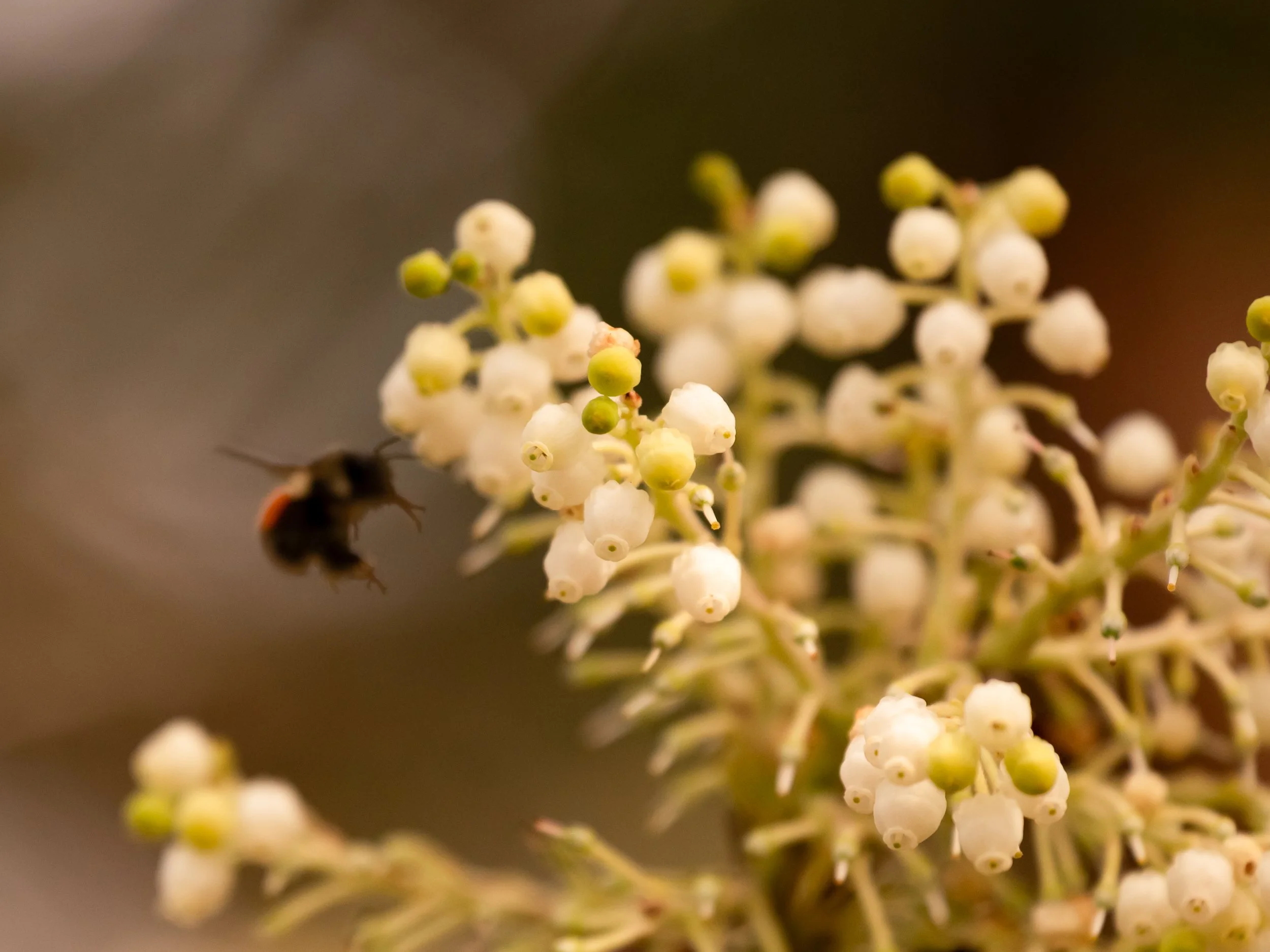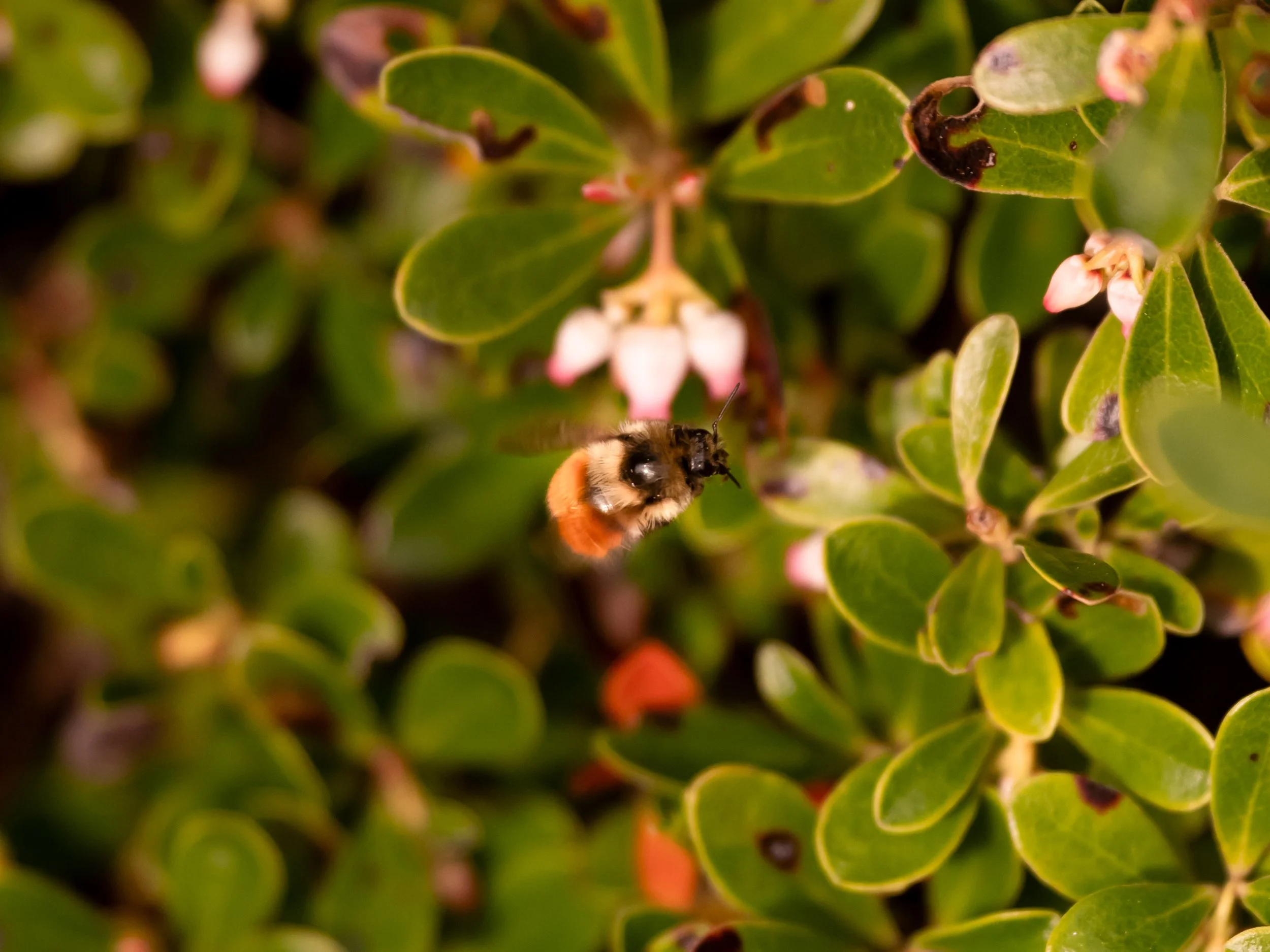The Bellingham Buzz
Bellingham’s bee populations and the city’s role in protecting them
Close up of a plant where bumble bees are found around Bellingham, Wash.
Story by Emerson Tubbs // Photos by Avery Robertson
July 7, 2025
The value of bees is a buzzing topic. Bumbling from bud to bud, they act as the gods of floral fertility. Without them, the botanical world as we know it would see a dramatic decline, from agriculture to the lilies and lavender of community gardens. With three national parks, 35 state parks and famed flower festivals, Washington state is known for being a leader in agriculture and conservation. Reasonably, the state’s pollinator conservation should thrive as well.
“Pollinator” is a broad title, including wasps, butterflies, moths, flies, small birds and bats, and of course, bees.
“[Bees] are by far the best pollinators ‘cause their bodies have so many hairs on them…so when they are messing around on the flower… they are accumulating a lot of pollen,” Jim Davis, a local entomologist, said.
For the past five years, the City of Bellingham has been an official member of the celebrated national organization, Bee City USA. The city’s name has been placed alongside 236 other cities, united in agreement to protect bees.
This year was set to be Bellingham's last among those ranks.
Bee City USA is a nationwide organization founded in 2012 by Phillis Styles. In 2018, the organization was adopted by the international non-profit Xerces Society, and the movement further escalated. Bee City USA also includes Bee Campus USA, a project centered around college campuses. Western Washington University has been an affiliate since August of 2022.
Totaling the two, the project has 448 affiliates across 47 states and territories in the United States.
In 2020, former Mayor Kelli J. Linville officially designated Bellingham as a Bee City. In doing so, the city created the Bellingham Bee Committee , which works on habitat improvement, pesticide reduction and outreach.
All 448 affiliates submit data to the Xerces Society, which releases annual reports on Bee City’s website. In approximately 10 pages, the subsequent year’s data regales the public with tales of community involvement and stats of growth and decline.
“It's a time for them to reflect on their successes and what they’ve been working on, but it’s also a great way for affiliates to educate each other,” Laura Rost, the national Bee City and Bee Campus coordinator, said.
In shifting climates, bee monitoring and reporting can fall to the wayside. During the COVID-19 pandemic, many cities joined the program, but there were no consequences for not maintaining Bee City obligations until now.
The City of Bellingham has no past reports listed on Xerces Society’s website.
“I just reached out to Bellingham’s Bee City Committee and I didn’t hear back, and they did not report last year,” Rost said.
Being a sanctuary for bees means more than just collecting data.
Bee pollinating a native species of a plant.
Commercial honey bee colonies in Washington are at risk of a 70% die-off in 2025. The main reasons for this are disease, pesticide usage, and habitat loss.
Karly Kerr, co-founder of Northwest Apiary Services, spoke of her own experience with bee die-offs. In winter 2024, she unexpectedly lost all four of her hives. With the help of her beekeeper network, she reestablished three healthy hives by the end of April.
Kerr believes that the best response to bee decline is to build community knowledge and implant new hives. Due to the diversity of urban gardens and the small size of honey bee hives, cities are full of opportunities.
“We could have a hive in these parks, or on top of those apartment buildings, these are all things that we could do to increase the ‘bee city’, but it's not actively happening,” Kerr said, gesturing around Boulevard Park.
One of the main problems with keeping bees in city limits, however, is city policy, which restricts hive ownership to one per property.
“[If] there’s only one hive, you can’t medicate the sick hive with a healthy hive…but if you had two…you could be self-sustainable,” Kerr said.
In the face of disease or colony collapse, isolated hives have nowhere to seek aid. More hives mean more diversity and stronger colonies.
Honey bees make vital contributions to pollination efforts. Maintaining a honey bee hive means reaping honey and wax, allowing for a closer relationship between honey bees and their keepers.
These bonds are nearly completely absent towards native bees, despite their vitality in pollination.
“There’s ladybugs, there's all kinds of smaller insects, but they don’t produce another product,” Kerr said. “I think that’s the issue…[other pollinators] don’t have anything that’s desirable to humans. They are overlooked for that reason.”
While honey bees make vital contributions to pollination efforts, they receive more than their fair share of credit over butterflies, moths, birds, beetles, wasps, flies and especially other kinds of bees.
And yet, this commercial idol is not even native to North America.
While keeping healthy honey bees can boost pollinator populations, the money, space and maintenance required is not accessible for everyone.
“The fun thing about native pollinators is you don’t need to buy or build anything to support them. If you grow it, they will come,” Rost said.
Native bee habitat demands are simple: native flowering plants, pesticide-free forage and nesting sites. Where honey bees share space with hundreds and hundreds of comrades, native bees live the solitary life.
“70 percent of native bees are ground-nesting, so they don’t live in a hive…and 90 percent are solitary nesting, individually finding their habitat,” Rost said. “They want bare soil near flowers, they want dead stems, branches and logs, and dead leaves. That’s what you need…it’s way more hands-off than honey bee keeping, and it’s, frankly, way cheaper.”
The City of Bellingham may not have fulfilled its reports; however, according to the people of Bellingham, Bellingham is still a bee city.
In many cases, protecting the bees is a responsibility shouldered by the people. Shuksan Conservancy is a local organization known for its volunteer research and advocacy. Their research and team has grown over time, turning a routine outing in Heather Meadows into a published research paper in 2024.
The team’s monitoring projects emphasize the important relationship between native bees and native plants.
Bumble bee gliding between flowers.
“If we were to lose our native bee population… that's gonna seriously impact native plants, which depend on those native bees for pollination,” said Davis.
The Shuksan Conservancy includes Upper Skagit and Nooksack tribe representatives, resulting in close community bonds.
“We are working pretty closely with the Nooksack and Upper Skagit tribes, and their interest is first foods, which are traditional, native foods,” Davis said. “What…has really helped us a lot, is our recognition of the importance of first foods and their recognition of the importance of pollinators to first foods.”
Shuksan Conservancy is just one example of how community involvement and leadership can sow seeds of ecological resilience and build intercultural bonds as sweet as honey.
While community organizers are making great strides, city support can make bee conservation efforts more impactful.
Up until recently, the City of Bellingham was in danger of losing its Bee City certification, but that does not mean it is over for Bellingham’s bees.
As of May, 2025, the committee has expressed interest in ‘catch up’ reporting and restaffing the program to continue its certification.
“The City’s commitment to promoting pollinator habitat is not dependent on our association with Xerces and will continue regardless of our membership in the Bee City program,” Clare Fogelsong, Bee Committee climate policy manager, said in an email. “We understand the ecological significance of pollinators and will continue our work to protect them.”
Bee populations will fall. But they can also buzz back, with a little help.
There are ways that individuals can directly help, such as investing in native plants, refraining from pesticide usage and volunteering time to further research and education.
“It's not an emergency house on fire today, but we certainly need to do something now, to reverse the trends of slow decline,” said Davis.



